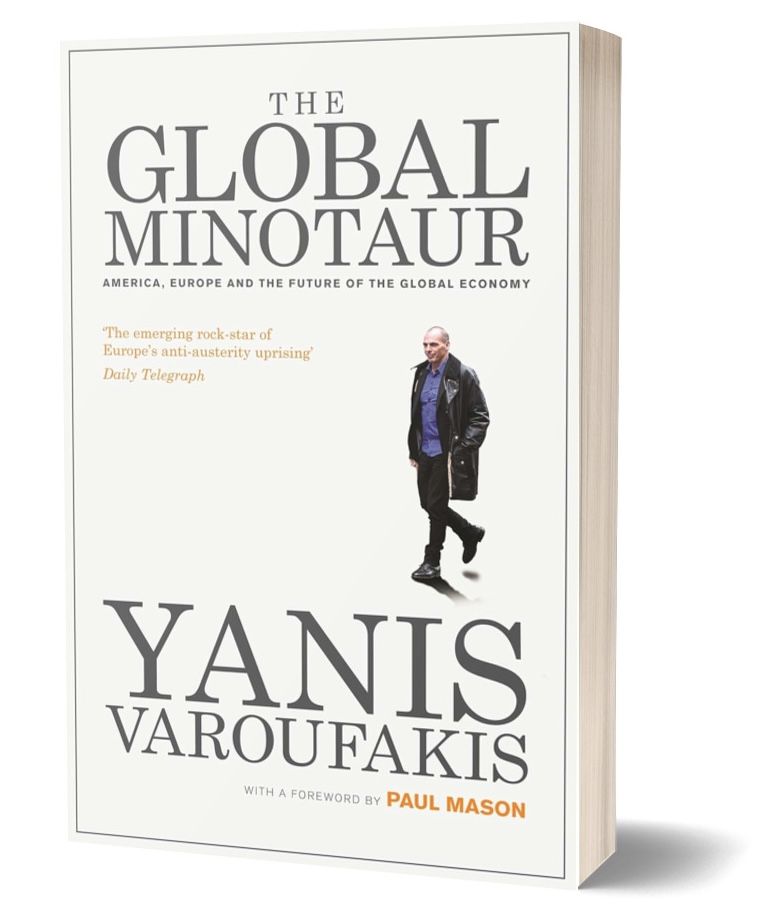The Global Minotaur: America, Europe and the Future of the World Economy by Yanis Varoufakis
Summary and takeaways from the book.
Keywords:
Deep State
Golden Age
Capitalism
Wealth Transfer
Nov 10, 2024
In the book, the author uses the term Global Minotaur to describe the global financial and monetary system.
"
‘Global Minotaur’ was US capitalism centred on Wall Street, extracting tribute from the world after 1971".

Minotaur: mythical beast from Greek mythology that has head of a bull and body of man.

ISBN: 978-1783606108
Published: July 15, 2015
Pages: 304
amazon
The author
Yanis Varoufakis is an economist, politician, author and the former finance minister of Greece.
He was associate professor of economic theory at the University of Athens.
He was Finance Minister of Greece from January to July 2015 during the crucial time of Greek debt restructuring.
He also co-founded Democracy in Europe Movement 2025 (
DiEM25), a left-wing pan-European political party.
Minotaur is a mythical beast from Greek mythology that has head of a bull and body of man. It feeds on human sacrifice sent to it as tribute.
In the book, the author uses the term
Global Minotaur to describe the global financial and monetary system.
"
‘Global Minotaur’ was US capitalism centred on Wall Street, extracting tribute from the world after 1971".
"Varoufakis learned a lesson on behalf of the entire European left: politicians do not control Europe; the Minotaur does."
The Global Minotaur
A
global surplus recycling mechanism (GSRM) is required to deal with trade imbalances. E.g. if India has $1 trade deficit with China, how will China get compensated for its trade surplus? China has no need for Indian currency.
No such global surplus recycling mechanism (GSRM) was formalized in Bretton Woods conference in 1944.
The author shows that it is the lack of a automated global surplus recycling mechanism (GSRM) that creates trade surplus and deficit and global imbalances. This favors the USA.
"
The Global Plan unravelled because of a major design flaw in its original architecture. John Maynard Keynes had spotted the flaw during the 1944 Bretton Woods conference but was overruled by the Americans. What was it? It was the lack of any automated global surplus recycling mechanism (GSRM) that would keep systematic trade imbalances constantly in check."
If India has $1 trade deficit with China, India can compensate China with US Dollar. This works but it also gives USA "
exorbitant previlige" and also has its consequences.
"
Washington thought that global trade imbalances would favour America in perpetuity, casting in stone its status as the world's surplus nation.
"Then the power bestowed upon the United States by the surpluses it extracted from all over the world would be utilized benevolently and efficiently in order to manage the world economy along the lines of an enlightened hegemony."
"Indeed, this is exactly what the United States did: it graciously recycled the American surpluses in the form of capital injections into Japan, Germany and other deserving regions."
"Alas, US policy makers failed to foresee that global imbalances could undergo a drastic inversion".
Triffin's Dilemma
Triffin's Dilemma is a Dilemma in economics. It was first observed by Belgian economist Robert Triffin.
"
A reserve currency can lead to a trade deficit by elevating the exchange rate and hurting exports."
America's "
exorbitant previlige" has it's downsides. Demand for US Dollar makes US Dollar strong but then pushes manufacturing out of USA and hurting exports.
Growing and sustaining the Global Minotaur
The author lists 4 reasons that grew and sustained the Global Minotaur:
Reserve Currency Status: America's "
exorbitant previlige". Every country needed US Dollar.
Rising energy costs: "
As for non-US producers, the dollar’s reserve currency status, coupled with Volcker’s huge interest rates, magnetized their petrol dollars to New York where they metamorphosed into shares or US government bonds."
Focus on productivity: American productivity grew faster than Europe and Japan. This led to increased prifitability for USA companies.
"
Increasing US profitability is the third reason why foreign (non-US) capital willingly fell into the Global Minotaur’s lap, migrating at great speed and in unprecedented volume from Frankfurt, Riyadh, Tokyo, Paris and Milan to New York."
Geopolitical might: weaponizing World Bank loans.
"
the interest rate rise that was part and parcel of the Global Minotaur’s own rise to prominence proved more effective in destroying the enemies of US foreign policy around the globe than any military operation the US could ever mount."
The author gives example of ex-Soviet countries: "
when interest rates soared, as part of Volcker’s strategic ‘disintegration in the world economy’ , communist regimes in Warsaw, Bucharest and Belgrade began to feel the pinch. Once they realized their grave dependency on the ‘capitalist enemy’ , they gave their all to repay the debts as quickly as possible, imposing particularly harsh austerity measures on their own workforces. The result was mass discontent, major unrest and the first stirrings of organized opposition, e.g. the Polish trades union Solidarity, which was soon to spearhead a chain of events leading to the first collapse of a communist regime."
"
This never-ending haj by the world’s capital to the global financial Mecca nourished America’s deficits to such an extent that they soon began to resemble a mythological creature, a Global Minotaur on whose presence the US economy became dependent and whose influence quickly extended to every region of the globe."
The "
Minotaur’s minders (strategists like Henry Kissinger and Paul Volcker)" kept this system working.
Financial engineering, not innovation
Leveraging, options, and hedge funds amplified the return from capital by financial engineering.
"
in 2007, that ratio had risen by 640 per cent: every $1 of world income corresponded to almost $12 worth of derivatives."
None of this financial engineering was innovative, but merely sustained by generous inflows of capital from outside USA.
"I wish someone would give me one shred of neutral evidence that financial innovation has led to economic growth; one shred of evidence."
"The only financial innovation I recall in my long career was the invention of the ATM."
- Paul Volcker, Former Chair of the Federal Reserve of the United States, 2009.
"
What holds [the US economic success story] all together is a massive and growing flow of capital from abroad, running to more than $2 billion every working day, and growing..."
"
The difficulty is that this seemingly comfortable pattern can’t go on indefinitely. I don’t know of any country that has managed to consume and invest 6 per cent more than it produces for long. The United States is absorbing about 80 per cent of the net flow of
international capital." - Paul Volcker, 2005.
End of the Minotaur
"
The Crash of 2008 seriously wounded the Global Minotaur. Since 2008–09, the Crisis has eased. But it has not gone away. The beast is down and no one any longer fulfils its crucial function of keeping America’s twin deficits running and absorbing the world’s surpluses. Thus, the Crisis is constantly metamorphosing, taking its toll differently in different places."
The Minotaur cannot be killed as it is too powerful. It will die its own death and that time is here now.
When the Minotaur (global financial and monetary system) dies, people go into a state of "
aporia – that state of intense puzzlement in which we find ourselves when our certainties fall to pieces; when suddenly we get caught in an impasse, at a loss to explain what our eyes can see, our fingers can touch, our ears can hear."
"
Anxious disbelief replaced intellectual indolence. The figures in authority seemed bereft of authority. Policy was, evidently, being made on the hoof. Almost immediately, a puzzled public trained its antennae in every possible direction, desperately seeking explanations for the causes and nature of what had just hit it.
As if to prove that supply needs no prompting when demand is plentiful, the presses started rolling. One after another, the books, the articles, the long essays – even the movies – churned through the pipeline, creating a flood of possible explanations for what had gone wrong. But while a world in shock is always pregnant with theories about its predicament, the overproduction of explanations does not guarantee the aporia’s dissolution."
Austerity has been the narrative to siphon welath from the public and middle class to the Global Minotaur - the global capitalists and oligarchs.
"
Austerity economics, and the primacy of the banks over households, businesses and state treasuries, have been the articles of faith".
Eventually, "
the mythical beast was killed by unsustainable economics".
The advice he gives to new proposals that make things work: "
I peruse the wastelands of my country, every now and then giving the odd interview to various networks that pose the same question over and over again:
what should Greece do to extricate itself from its Great Depression? How should Spain or Italy respond to demands that logic tells us will make things worse? The answer I deliver with increasing monotonousness is that there is nothing that our proud countries can do other than to say ‘No!’ to insane policies whose real objective is to deepen the depression for apocryphal reasons that only a close study of the Global Minotaur’s legacy can reveal."
The Great Reset
Global economy needs a new global surplus recycling mechanism (GSRM) to deal with trade imbalances. E.g. if India has $1 trade deficit with China, how will China get compensated for its trade surplus? China has no need for Indian currency.
No such global surplus recycling mechanism (GSRM) was formalized in Bretton Woods conference in 1944.
"
At the Bretton Woods conference, John Maynard Keynes and Harry Dexter White clashed over the type of GSRM that was best equipped to keep the post-war world economy on a sustainable path (see chapter 3). Keynes had wanted a formal, institutionalized GSRM that would automatically recycle surpluses, thus curtailing both surpluses and deficits at once. White, on the other hand, insisted on America’s right to run large surpluses and to choose, as it pleased, the ways and the means by which these surpluses would be recycled. White, of course, got his way and the Global Plan allowed the United States the privileged role of managing and maintaining the GSRM in accordance with its judgement and interests."
In the future post-Great Reset, Bretton Woods 3, the global surplus recycling mechanism (GSRM) will rely on transfer of Gold between countries. E.g. if India has $1 trade deficit with China, India will send $1 worth Gold to China to balance the trade deficit.
The end of the Global Minotaur will trigger "
unwinding of a more profound asymmetry in the global economy, the rebalancing of a US-centric world".
This will be the Great Reset.
It will lead to $2bn a day less money coming to USA, less interference of USA in global affairs, decline of the West, and rise of the Global South and BRICS.
Related articles
The New Silk Roads: The New Asia and the Remaking of the World Order by Peter Frankopan
Great Power Politics in the Fourth Industrial Revolution by Glenn Diesen
External Links

